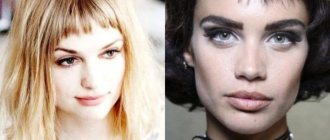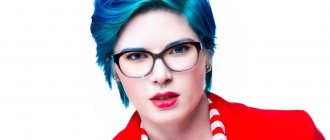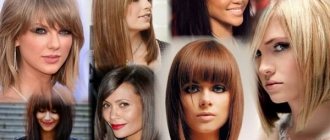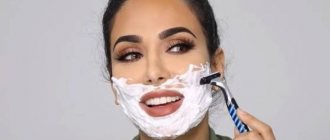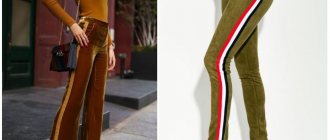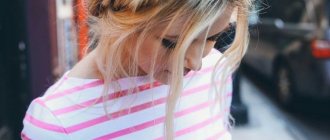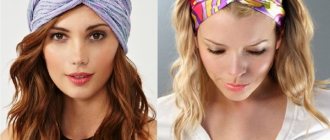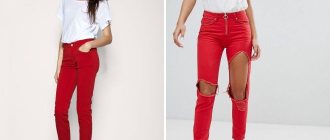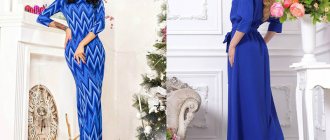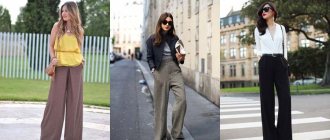Features of the technology
To create cut strands, special thinning scissors are used. They were invented in the 30s in the USA, one of the blades cut hair, and the second had teeth. It was difficult to work with such a tool - it was not always possible to predict the result of the haircut. In the 50s, a modernized version of thinning scissors with notches on the teeth of the blades appeared in Europe. This allowed hairdressers to control the quality of the cut and the volume of hair, producing more accurate haircuts.
Today, single-sided and double-sided scissors are used for thinning; the choice of a specific model depends on the experience of the master and the tasks assigned to him. With this tool you can thin out both bangs and any other part of the hairstyle.
There is a thinning technique using regular scissors and a straight razor. But in practice it is rarely used due to the length and complexity of the process.
Methods for thinning
During thinning, the hair is cut at different levels, making the bangs look original and become visually lighter and neater. There are several methods for performing thinning, the most popular of which are:
- Slicing. The strands are grabbed with scissors almost at the very roots; after cutting they take the shape of an elongated oval. Using this technique, you can achieve both smooth and jagged transitions.
- Pointing. With this thinning, only the corners of the hair are cut with the tips of scissors, which allows you to achieve an unusual “fringe” effect.
- Mush. Regular or thinning scissors are suitable for this purpose. Individual wide curls are cut in semicircular movements, as a result of which they curl slightly upward and break up into several strands.
- Plunge. Used to visually increase the volume of bangs. Each strand is cut separately, and cuts are made along the entire length of the hair, starting from the roots.
- Picketage. Suitable for thinning short bangs. The edges of the curls are lifted with a flat comb and then processed with serrated scissors.
Thinning is not recommended to be done frequently, since after the procedure the hair becomes thinner and the risk of split ends increases. Before you decide to thin your bangs, you should first consult with an experienced hairdresser.
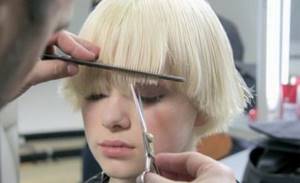
Thinning is not recommended for very thin, brittle and prone to hair loss.
Varieties
One of the advantages of thinning bangs is the ability to use this technique for bangs of different lengths. When choosing a thinning method, you should consider your face shape, haircut type, age, and the specifics of your haircut.
Short
This type of bangs is not suitable for every woman; it is often chosen to create a daring and youthful look. It can make the face visually slimmer and more toned; it looks best with an oval face shape. Short thinned bangs can be combined with hair of different lengths, but the most successful option is a medium and asymmetrical haircut.
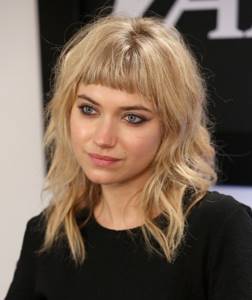
Long
With this type of bangs, the front profiled strands can reach the chin or earlobe. The haircut helps soften the angular features of the face and gives the hair a well-groomed appearance. Long bangs can be combined with hairstyles of different lengths, but look especially attractive on medium haircuts and festive evening styles.
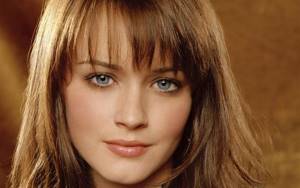
Straight
This type of bangs is easy to recognize by the cut that runs parallel to the hairline at the forehead. It can be straight or graduated at the tips. Profiled straight bangs are an excellent solution for long and medium hair. In this case, light thinning is usually carried out without disturbing the even cut line.
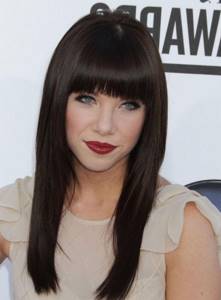
Oblique
This type of bangs is best suited for those with a square or rectangular face. A beveled cut can smooth out angularity and visually add volume to the hair. Oblique profiled bangs organically complement the bob haircut, revealing one side of the forehead.
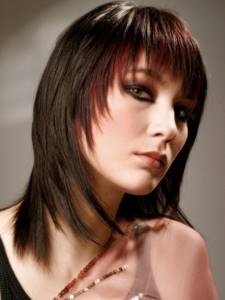
Rare
Strongly thinned bangs are recommended for those with thin hair of any length. As a rule, this option is used to make the haircut look neat. With deep thinning, there is a risk of making the hairstyle too sparse, so it is important to choose an experienced hairdresser for the job.
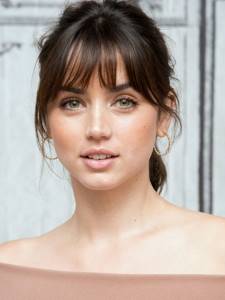
Kinds
Choosing bangs is a responsible matter. After all, cutting off hair is much easier than growing it. Consult a stylist to choose the best option for your face.
Short
Often performed on thin, unruly hair, as it does not emphasize its structure. Give preference to this option if you have wide cheekbones and a massive chin. To complete the look, go for choppy ends. Find out more about short bangs and the features of their styling on our website.
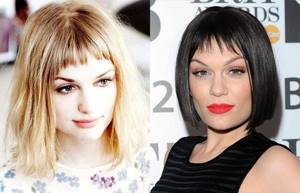
Long
Perfectly masks small defects in appearance. Suitable for women with a rectangular face shape, heavy cheekbones and a rough chin. Makes the look airy and the hairstyle well-groomed. What kind of bangs are called long (extended), we have prepared its varieties for you on the website.
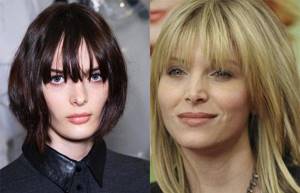
Straight
The classic version, in which an even cut is made at the same level. This bangs will emphasize the expressiveness of the eyes and make an elongated face more rounded. Optimal for soft, unruly hair. Will complement any haircut, including short ones. Pairs best with a bob.
We recommend reading: Who does straight bangs suit and doesn’t suit?
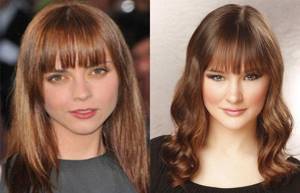
Oblique
It will restore freshness to your face, help you visually lose several years, and also correct your facial features. For example, a round one will visually stretch it, and a square one will soften it a little. Sloping sparse bangs do not require long styling. You can even do without a hairdryer. Find out in detail how to cut side bangs at home on our website.
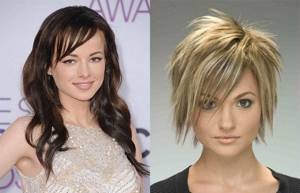
Arch shaped
The strands are sparse in the center, and thicker on the sides. Such bangs are also convenient to style. It harmonizes with long and medium hair. When choosing a semicircular option, cut your hair using any technique. Semi-circle bangs - whether fashionable or not now, read on our website.
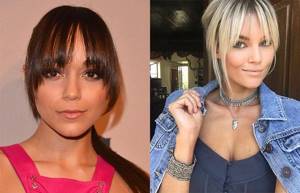
Who is it suitable for?
Thin bangs are suitable for almost any age, style and hair type. But there are some features:
- thinning is ideal for thick and unruly hair, which simplifies the styling process;
- For those with an oval or round face shape, it is better to choose a torn shape of profiled bangs;
- the thinning technique allows you to highlight inexpressive facial features: lips, eyes, small nose;
- beveled profiled bangs will help correct the shape of the face and disguise its imperfections;
- thinned bangs look especially good on hair of a dark shade - this allows you to enhance your appearance and cut lines on your hairstyle.
You should refrain from thinning if your hair is sparse and very thin, and the ends are severely split. Owners of curly and curly hair should be careful when thinning out their bangs, as this can lead to excessive fluffiness of the strands.
Thinning gives especially noticeable volume to cascading hairstyles. When creating such haircuts, thinning is a mandatory final step.
Types of “liquid” bangs
Rare bangs, as we noted above, can have different shapes - this is what makes them universal and suitable for any type of face!
side bangs
Side bangs hide part of your face, even if you choose the option with sparse strands. At the same time, such bangs add naturalness to the hairstyle and youth to the image!
Long bangs
View this post on Instagram
Posted by Biolage (@biolage)
Long bangs below eye level are always difficult: often they get in the way so much that you want to grow them out as quickly as possible. But look how beautiful the long sparse bangs look, smoothly turning into curls, how they emphasize the tenderness and femininity of the model’s image!
Torn bangs
View this post on Instagram
Posted by Matrix (@matrix)
Torn edges instantly add dynamism and style to the look, and also do a great job of balancing the proportions of the face. This bangs looks more voluminous than most others, which will certainly appeal to those with thin hair in a short or medium haircut.
Straight
View this post on Instagram
Publication from
